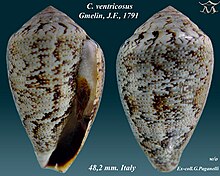| Conus ventricosus | |
|---|---|

| |
| Apertural and abapertural views of shell of Conus ventricosus Gmelin, J.F., 1791 | |

| |
| Scientific classification | |
| Domain: | Eukaryota |
| Kingdom: | Animalia |
| Phylum: | Mollusca |
| Class: | Gastropoda |
| Subclass: | Caenogastropoda |
| Order: | Neogastropoda |
| Superfamily: | Conoidea |
| Family: | Conidae |
| Genus: | Conus |
| Species: | C. ventricosus
|
| Binomial name | |
| Conus ventricosus Gmelin, 1791
| |
| Synonyms[1] | |
|
See "List of synonyms" | |
Conus ventricosus, common name the Mediterranean cone, is a species of sea snail, a marine gastropod mollusk in the family Conidae, the cone snails and their allies.[1][2]
- Conus ventricosus mediterraneus Hwass in Bruguière, 1792, is a recognized subspecies.
Like all species within the genus Conus, these snails are predatory and venomous. They are capable of "stinging" humans, therefore live ones should be handled carefully or not at all.
